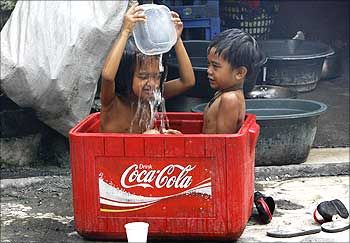 Almost 70 per cent of India’s industrial water is consumed by thermal power plants alone, said Chandra Bhushan, deputy director general of the Delhi-based Centre for Science and Environment (CSE).
Almost 70 per cent of India’s industrial water is consumed by thermal power plants alone, said Chandra Bhushan, deputy director general of the Delhi-based Centre for Science and Environment (CSE).
A look at India’s industrial landscape shows soft drinks is not the only water-intensive business. Steel, for instance, needs 7-10 metre cubes of water a tonne during production. Water consumption in paper is even higher at 75-100 metre cubes a tonne. Power needs about three-five metre cubes of water a megawatt hour.
Soft drinks is similar, at three-five metre cubes of water for production of one metre cube of a carbonated beverage. This is if quantum of water is taken as the parameter of comparison between the two industries.
But Bhushan insists there can be no comparison between power and soft drinks.
“You have to bear in mind that the unit of production is different for the two industries. In power, it is megawatt hour, and in soft drinks, it is metre cube. There can be no comparison here. Suffice to say that water consumption by some industries is high and soft drinks fall in that league,” he said.
Of the other 30 per cent industrial water users in India, there are quite a few sectors such as engineering, paper and pulp, textiles, iron and steel, sugar, cement and fertilisers that are water guzzlers. CSE did not give the precise break-up of the amount consumed by these industries.
But besides creating scarcity, high water-consuming businesses also pollute, Bhushan said. “On an average, for every litre of polluted water discharged, five to eight litres of usable freshwater is polluted.”
Ineffective industrial policy and production processes, Bhushan said, are at the heart of the issue concerning excess usage of water by industries. “For instance, both paper and iron and steel industries in India consume twice as much water per tonne of production as their global counterparts. This can be reduced with effective guidelines, as well as a change in the production processes adopted by user industries.”
With regulatory pressures considered a manageable cost by most in industry, Bhushan says, the level of seriousness and commitment required to address the issue of water management does not exist at the moment. “This attitude will have to change as competition for water from the domestic sector grows, even as industrial water consumption begins to peak.”
According to CSE, water demand for irrigation will drop to 637 billion cubic metres in 2050 from 675 in 2025, while domestic users will grow to 101 from 66 in the same time and industrial users will grow to 161 from 92.












 © 2025
© 2025